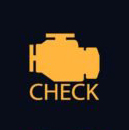Ever notice your car’s instrument cluster lighting up like a Christmas tree when you start it up? All those lights and symbols tell you what your car is up to and, more importantly, if something is wrong.
When your car starts up, most of those lights should automatically turn off—those initial blinks are actually a quick test to make sure they work properly. If one stays lit and you aren’t quite sure what it’s saying, read on.
Note that while most lights and symbols are universal, your particular vehicle may not have some of them, or might use a slightly different symbol for a specific warning. Either way, be sure to take a look at your car’s owner’s manual for details on a particular warning light or symbol you come across.

Malfunction Indicator Lamp: More colloquially known as the “check engine” light, this symbol lights up when there’s something wrong with your car, chances are good this is the symbol that lights up. The check engine light covers a wide gamut of issues that could pop up at any time—it could just be a loose gas cap, or a faulty mass airflow sensor. Mechanics diagnose these by using OBD-II scanners, but you can easily buy one for under $20 and figure out the problem yourself.

Fuel Gauge Symbol: This light sits near your fuel gauge, but did you know the small arrow next to the symbol actually means something? It points to the side of the vehicle that the gas cap is on. You probably already know where the gas cap is on your vehicle, but when driving a rental car or a friend’s car, it’s handy to know.

Battery Warning Light: While this symbol looks like a car battery, it’s really warning you about the recharging system that keeps your battery juiced up, not the battery itself. This could mean there’s corrosion on the battery terminals preventing the battery from accepting a charge, or it could be a more serious problem, like a failing alternator.

Oil Pressure Warning Light: When this lights up, it means the engine isn’t circulating oil effectively. You could be low on oil (which could point to a leak) or the oil pump may have failed. Either way, you’ll want to stop driving and pull over immediately if this light comes on, because inadequate oil flow can destroy the engine beyond repair if continued to be driven. Some cars also have oil pressure gauges that display what the oil pressure is at all times.

Temperature Warning Light: If this lights up, it means the engine is overheating and you’ll want to stop driving and pull over right away, as excessive heat can destroy an engine. When an engine overheats, there is a problem with the cooling system. The most likely suspects are the radiator (or the radiator fan), water pump, or thermostat. Many cars have temperature gauges that display the engine’s temperature at all times.

Tire Pressure Warning Light: If your car has a tire pressure monitoring system (TPMS), it can alert you to low tire pressure in any one tire. Changes in air temperature can have an effect on tire pressure, and your tires slowly lose a little pressure every few months. So it’s always a good idea to check the tire pressure every so often and top it off. If the light keeps turning on, you may actually have a leak somewhere.

ABS Warning Light: ABS stands for anti-lock braking system, and most modern vehicles come equipped with it. It’s there to prevent your wheels from locking up under heavy braking. When this light comes on, your ABS system could have a failed sensor, or a problem with its own computer module. The brake system will still work, but the ABS needs to be checked out.

Overdrive Symbol: Overdrive is the highest gear available in your car’s transmission. It’s used when traveling at cruising speeds to save fuel by lowering the RPMs. It can be turned on and off, so when you see this symbol illuminated in the instrument cluster, it means that overdrive is on and can be utilized. Some cars will instead have a “O/D Off” symbol that stays illuminated whenever overdrive is not in use.

Electronic Stability Control Symbol: Depending on your car, Electronic Stability Control (ESC) can be manually turned on and off, or activated automatically. Either way, this light comes on when your car’s computer detects a loss of traction. Once that happens, the car will strategically adjust engine power and engage the brakes in order to regain traction. Whenever this happens, the ESC light will light up. If it can be turned on and off manually, this light will stay illuminated when ESC is on.

High Beams Symbol: This typically blue light (sometimes green) means your headlights’ high beams are turned on, and are probably blinding other drivers that you’re passing by on the road—turn them off when you don’t need them, or if you see another car’s headlights coming in the opposite direction.

Cruise Control Symbol: This light illuminates whenever cruise control is activated. Your car may also have a separate light indicating that the cruise control feature is on and ready to be activated, sometimes denoted by a separate “CRUISE” symbol in the instrument cluster, or just a small LED light on the button itself.

Economy Mode Symbol: Many fuel-efficient vehicles will have an “ECO” symbol that lights up letting you know your car is operating at peak fuel efficiency. Some cars are even advanced enough to automatically disable engine cylinders once you’re at a steady cruising speed. In other vehicles, you can manually turn on and off Eco Mode.
Did we miss anything? Have a weird story about an engine light nightmare? Let us know in the comments, or find us on social media! Until next time, happy fixing!
Title image by kecko/Flickr







5条评论
The tire pressure warning light on my 2007 Prius started flashing for one minute, then staying on solid. Pressure was good in all tires. A bit of research revealed that the sensors in the wheels contain a battery with a 7-10 year life. The dealer wants $1,000 to change all 4 sensors, so I am going back to frequent pressure testing, which is what we did before TPMS. If I keep the car long enough to buy new tires I will buy new sensors and have them installed during tire replacement. Otherwise I may resort to the tried and true “Black tape over the light” fix.
jimstutsman - 回复
Jimstutsman-I have the same issue with the tpms symbol. Mine is off in the summer and on solidly in the winter with the cold weather change. The tire pressure is not the problem it is because the batteries in the sensors are going. I also, said no way to the hefty price tag to change them. There is a way to change them yourself. You can buy a tpms programmer and the replacement sensors. It’s a lot of work and I have decided to just check the air pressure as needed too. The diy cost for me for all 4 tires would have run about $200 though if anyone was curious.
Donna Smith -
Read the vehicle’s owner manual for correct information o the TPMS. My wife’s 2009 Chevy Equinox has a simple procedure to relearn all the sendors, since I have to do it after every tire rotation or replacement. No tool is needed!
rayramirez - 回复
May I add that in my last 2 vehicles a warning indicator indicating failure of the ESC system was actually caus3d by the battery going flat. So while the Battery Warning Light may not be a reliable indicator to change your battery, the ESC fault indicator can be!
Damon Schultz - 回复
Ohhhh wow what a dummy
Gurl - 回复